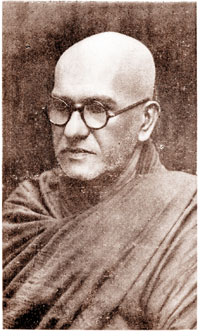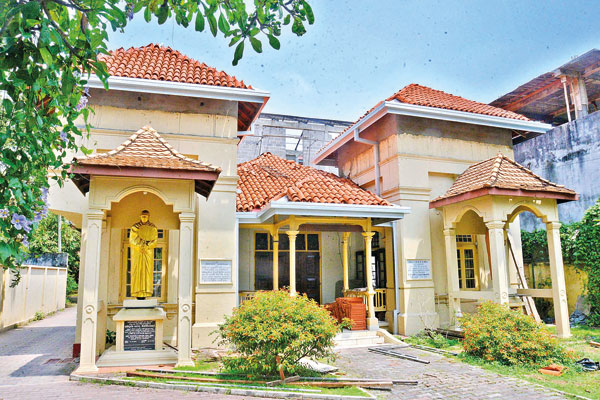Vajirarama’s gift to the Buddhist world
View(s):- The temple’s valuable library marks its centenary today
By Prof. Sandagomi Coperahewa
More than a century old, Siri Vajiraramaya in Bambalapitiya holds a special place as a temple that pioneered the Buddhist revival and religious progress in the country during the twentieth century.

Pelene Maha Nayaka Thera
It has produced Dhamma emissaries who have spread the teachings of Buddha, Dhamma preachers who have enlightened minds, and scholar monks who have enriched literature with their writings. The temple also hosts a Dhamma school that imparts knowledge and a valuable library that contains Dhamma books, making it a gift to the Buddhist world. The library marks its centenary today, July 14, 2024.
Vajirarama thus is revered by Buddhists from both home and abroad for having significantly contributed to spreading Buddhism worldwide.
The religious mission of Siri Vajirarama in Bambalapitiya began around 1890 when local Buddhist dignitaries formed a Buddhist society called the “Dharma Samagama” to hold Dharma sermons and discussions. In 1898, they built a Dharma Hall (Dharma Salava) and performed many benefactions.
On July 27, 1901, after the establishment of the Dharma Hall on the land where today’s Siri Vajiraramaya is located in Bambalapitiya, the virtuous and wise young monk Pelene Sri Vajiragnana Thera was invited to reside there. The name ‘Vajiraramaya’ was given in honour of the monk who built a small hermitage in that Dharma Hall and developed the place with the help of donors and friends. Initially limited to only one hall, Vajirarama became a world-famous Buddhist temple due to his efforts. The adjacent road also became known as ‘Vajira Road’ because of Vajirarama.
This Dharma Salawa quickly became a prominent place among the local temples, due to the great respect shown by Buddhist people and lay-monastic scholars to the Ven. Pelene Vajiragnana Maha Nayaka Thera. The Thera, who held the title of Maha Nayaka of the Amarapura Sri Dharmarakshita Nikaya, prepared a ‘Vajirarama discourse’ (Vajirarama Katikavata) explaining how the monks of the Vajirarama sect should live and act and how the branch temples of Vajirarama should be governed.
In the 20th century, Vajiragnana Thera, who pioneered the religious and scholarly mission centred on the temple in Colombo, worked to turn his temple into a place of religious and national importance.

Siri Vajiraramaya: A temple that pioneered Buddhist revival
The Vajirarama Dhamma School, established in August 1918 under the guidance of Pelene Maha Nayaka Thera, has been dedicated to developing Dhamma knowledge among Buddhist children not only from the surrounding areas but also from other regions. Thousands of students have studied Dhamma at Vajirarama Dhamma School.
In 1936, Vajirarama began publishing a children’s Buddhist magazine called Bauddha Lamaya, which contained valuable articles for both children and adults. The magazine was initially prepared by Pamburana Metteyya Thera, who resided at Vajirarama. Additionally, the Dhamma school published an English magazine titled The Bosat and a Buddhist paper titled Lakbudu Sasuna for the benefit of Buddhist children in Colombo’s suburbs. Recognizing that the future development of a country lies in the hands of its children, the Maha Nayaka Thera wrote thousands of poems to guide children on a righteous path.
The Vajirarama is also credited with starting radio Bana sermons. On April 28, 1928, Pelene Maha Nayaka Thera delivered the first Bana sermon on the radio, introducing the tradition of giving a sermon for about an hour on a specific theme. This created a new tradition of Dhamma communication in Sri Lanka with the enlightening sermons of Narada Thero and Piyadassi Thero, who lived in Vajirarama.
Vajirarama is regarded as a seat of learning for learned monks, who engaged not only in collecting books but also in delivering Dharma sermons and writing texts. Pelene Maha Nayaka Thera nurtured a generation of renowned monks, upholding the supremacy encased in the yellow robe and embodying virtues such as discipline, modesty, and wisdom such as Narada Thera, Kamburugamuwe Mahanama Thera, Denipitiye Sumanasiri Thera, Madihe Pagnaseeha Thera, Ampitiye Rahula Thera, Pamburana Metteyya Thera, Kheminda Thera, Piyadassi Thera, Panwila Vipassi Thera, Urugamuwe Senananda Thera, Valgama Sugathananda Thera, Soma Thero, Kheminda Thera, Naotunne Gunasiri Thera, Kassapa Thera, Gnanaweera Thera, Gnanamoli Thera, Dickwelle Mahinda Thera and Gangodawila Soma Thera.
In addition to these disciples, there were also many other monks, such as Pandita Weligama Gnanarathana Thera, who worked at Vajirarama under the Dharmanthevasi of the great prelates who worked towards the enrichment of religion, country and language.
Modern opinions on not only Buddhism but also language and literature were expressed due to the calibre of the scholar monks who lived in Vajirarama. In the early decades of the 20th century, it was customary for the editors of newspapers and magazines to obtain scholarly articles from the Vajirarama monks. Pelene Maha Nayaka Thera was foremost among the monks with his ability to write essays in both poetry and prose giving priority to correct Sinhala usage,.
Due to the efforts of monks like Pamburana Metteyya Thera, Narada Thera and Piyadassi Thera, who revealed the truth of Dhamma in simple language, the knowledge of Dhamma spread more effectively. The series of books, Sadaham Maga and Dharma Sangrahaya, written by Narada Thera, received special guidance from the Maha Nayaka Thera. These were used in schools for many decades and monks were able to teach children even the most profound Dhamma very clearly because of their deep knowledge of Dhamma and proficiency in the Sinhala language. As a result, there emerged a group of Buddhists full of Dhamma knowledge and respect for the language.
The library of Vajirarama consisting of scriptures written in Sinhala, Pali, Sanskrit and Burmese, books on Sinhala language literature, English Dhamma books, as well as a rare collection of palm leaf manuscripts, is among the most important temple libraries in this country. It was opened on July 15, 1924, by the Colonial Secretary Cecil Clement at the invitation of Pelene Maha Nayaka Thera. The opening of this library attracted the attention of contemporary scholars and was widely publicized in Sinhala and English newspapers as a “valuable donation to the city of Colombo.”
Although it started with 200 books, the Vajirarama Library developed to a high level in a very short time. In the early decades of the 20th century, book publishers and printing houses that published pamphlets made it a practice to send a copy of their Dhamma books to Vajirarama. Additionally, Dhamma books and magazines were obtained from well-known book dealers. The Maha Nayaka Thera took the initiative to keep them in order and the Vajirarama Library was established as a great Dhamma library. Even today, scholars and researchers studying Buddhism and oriental languages make use of its resources.
Pelene Maha Nayaka Thera was known as the ‘Great Dharma Treasury of the East’ among his contemporaries. If a problem regarding the Tripitaka Dharma discipline arose, lay-monastic scholars looked to the Maha Nayaka Thera of Vajiraramaya for an answer. Scholars and political leaders made it a habit to visit Vajirarama to seek advice and guidance on various matters. Notable figures such as Sir D.B. Jayathilaka, Cumaratunga Munidasa, Martin Wickramasinghe, W. A. Silva, Peter Tudave Pandita Gunawardena, Katunayake Lionel W. de Silva (a well-known poet and author), Professor Gunapala Malalasekara, and David Karunaratne (a newspaper editor and well-known writer) frequently associated with Vajirarama monks and utilized its library resources to clarify religious and linguistic facts.
Vajiraramaya can be considered an unofficial Buddhist university that has shared the knowledge of the Dhamma with the world in the modern era. Narada Maha Thera, who became the chief incumbent of Vajirarama in 1955 after the passing of Sri Vajiragnana Thera, engaged in Buddhist missionary work worldwide and made a significant impact by composing books in both Sinhala and English. Piyadassi Thera, a renowned student of Pelene Maha Nayaka Thera, further elevated the name of Vajirarama globally by writing Dhamma books and spreading Dhamma.
After the death of Venerable Narada Thera in 1983, Madihe Pagnaseeha Maha Nayaka Thera became the chief incumbent of Vajirarama and emerged as one of the greatest Sangha leaders in the recent history of the country. He succeeded Pelene Maha Nayaka Thera as the Maha Nayaka of the Amarapura Sri Dharmarakshita Nikaya. Following the Vajirarama tradition, Madihe Maha Nayaka Thera refrained from political affairs, dedicating his time to the country and the Sasana. He pioneered numerous religious and social activities throughout the nation.
Siri Vajiraramaya commemorates the noble mission of a generation of monks who dedicated themselves not only to the Sambuddha Sasana but also to the socio-cultural and religious development of the country. It is currently led by Tirikunamale Ananda Maha Nayaka Thera, the chief prelate of the Amarapura Sri Dharmarakshita Nikaya, setting a precedent for future generations of monks.
(The writer is a Senior Professor and Head of the| Department of Sinhala, University of Colombo)
Searching for an ideal partner? Find your soul mate on Hitad.lk, Sri Lanka's favourite marriage proposals page. With Hitad.lk matrimonial advertisements you have access to thousands of ads from potential suitors who are looking for someone just like you.


